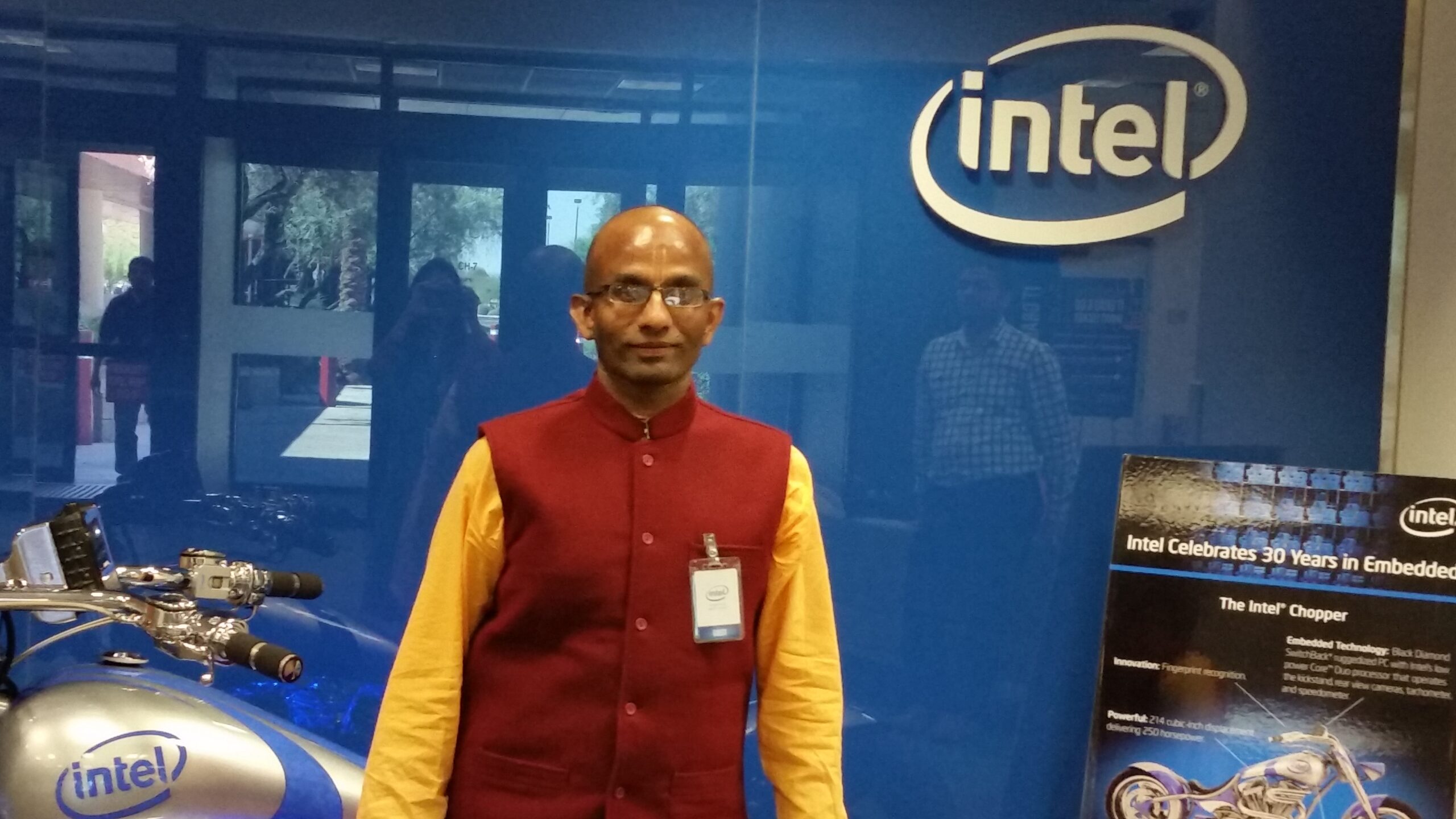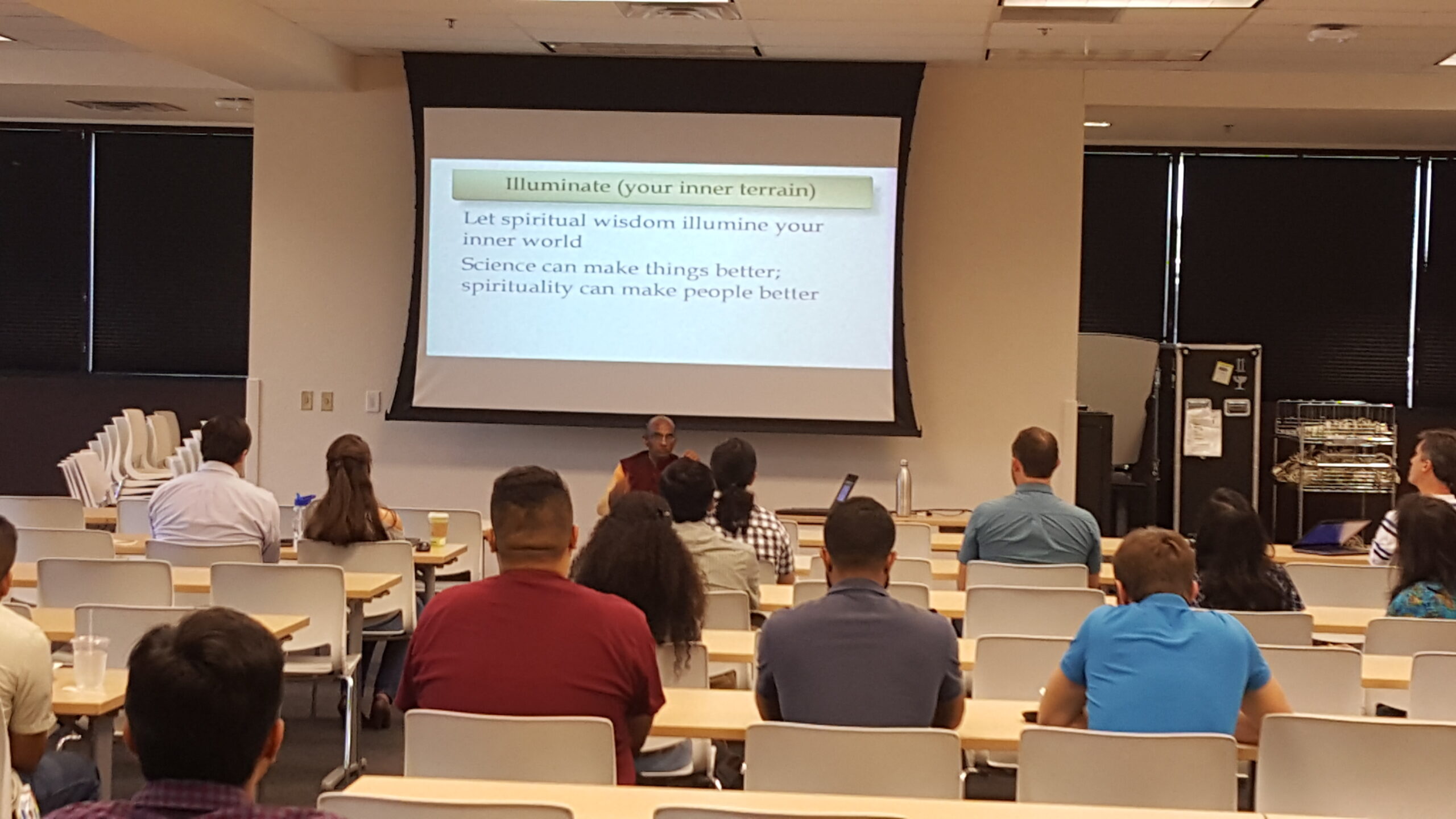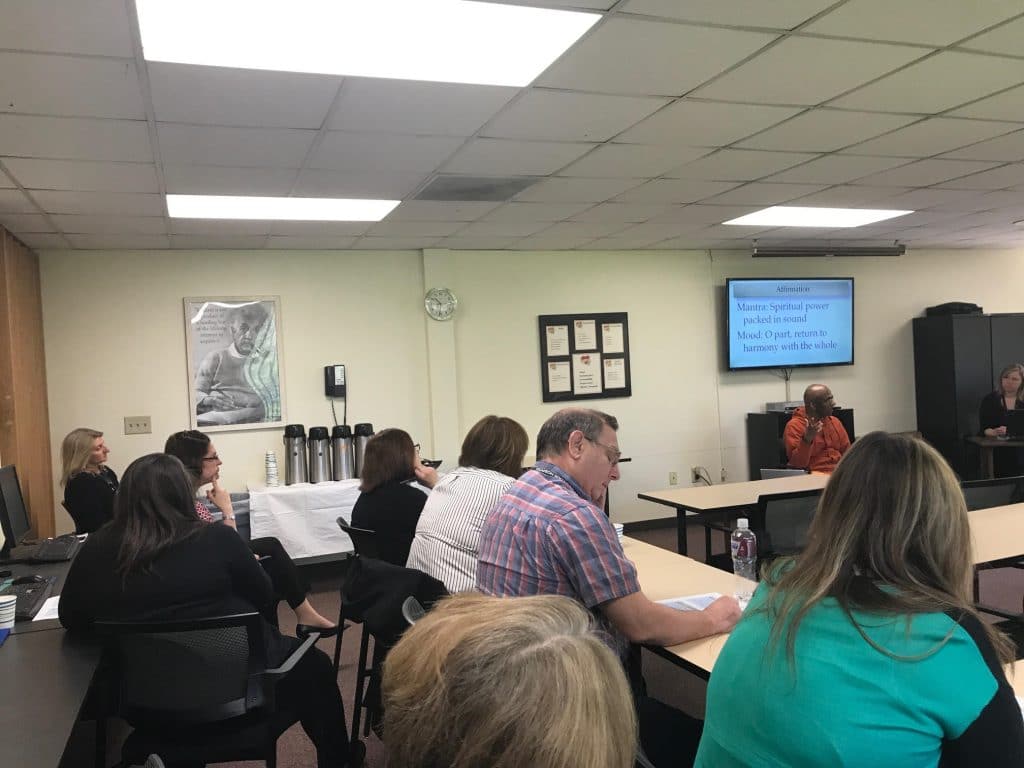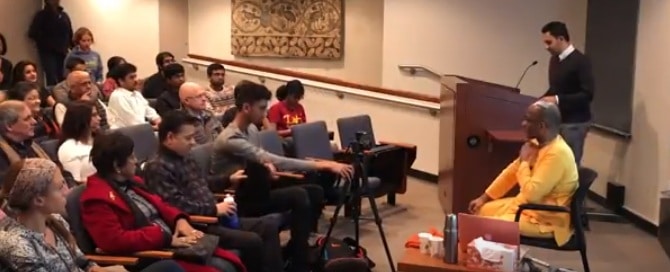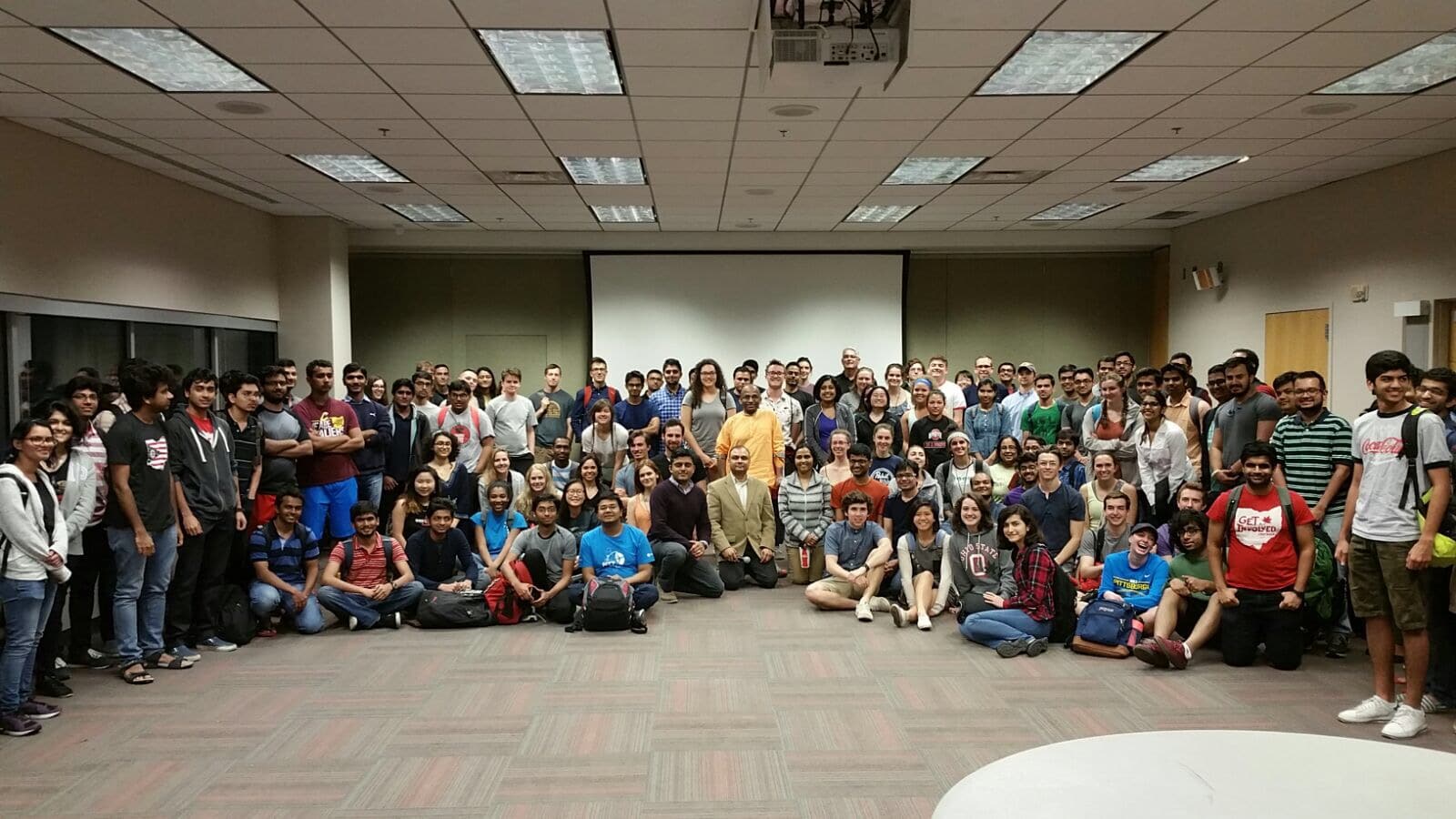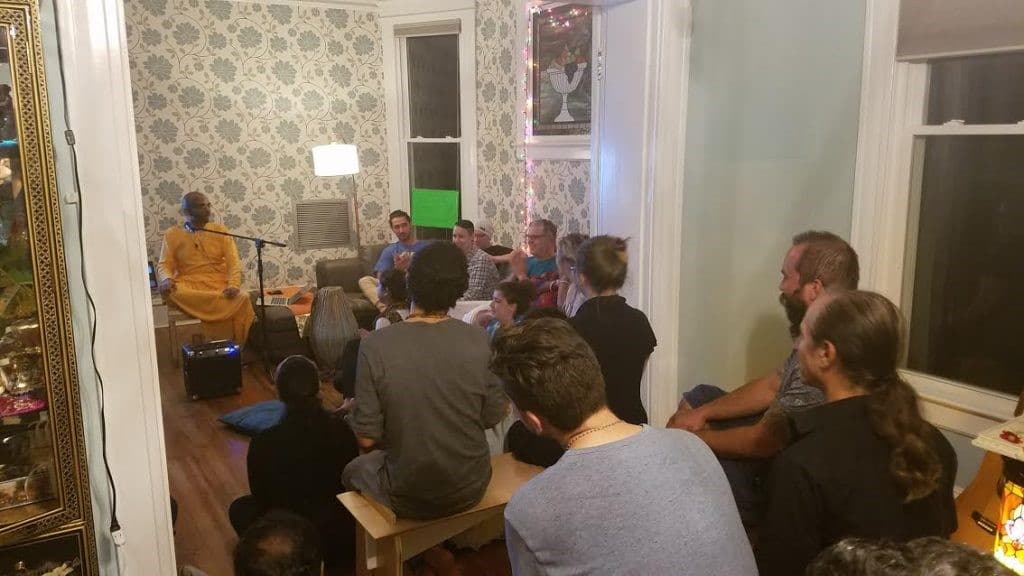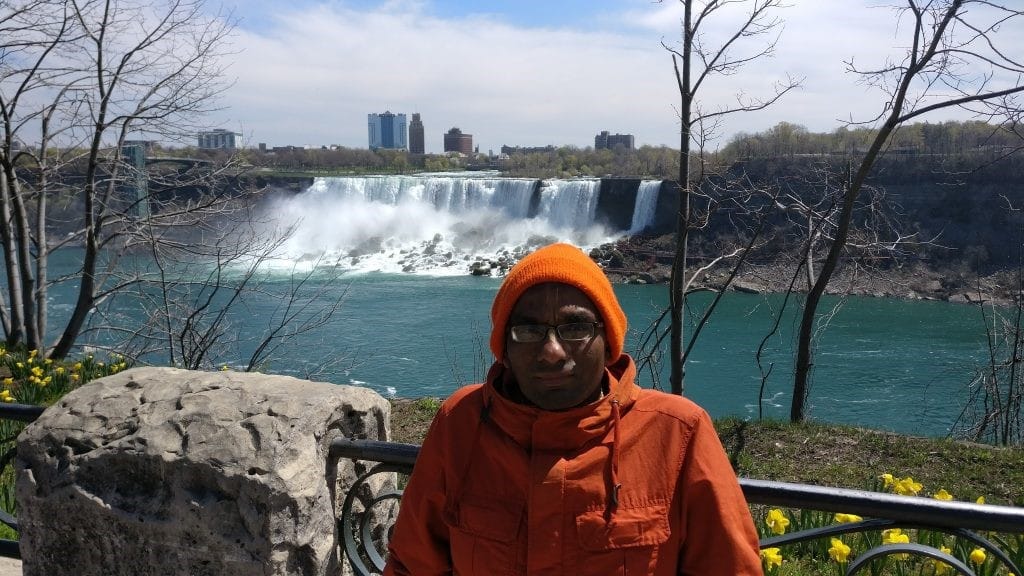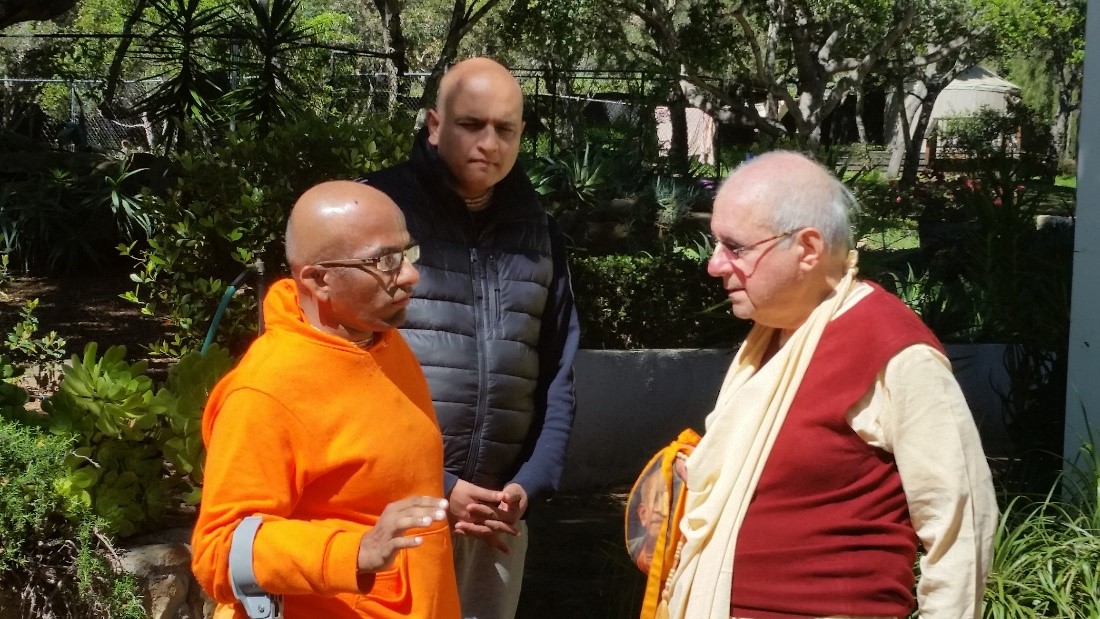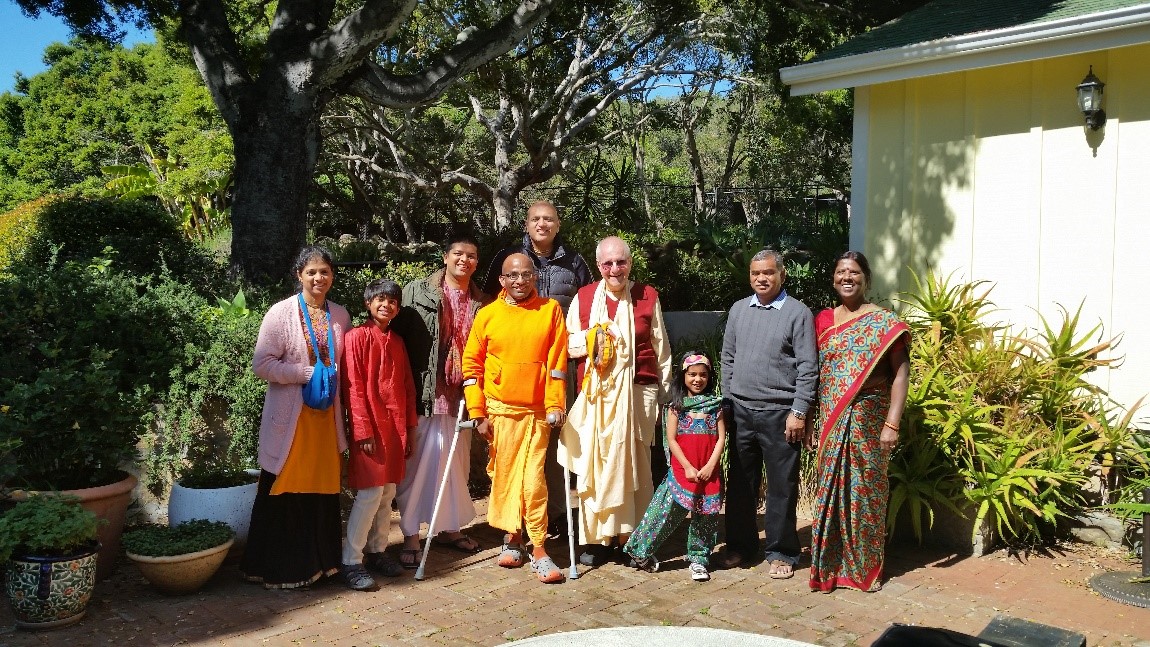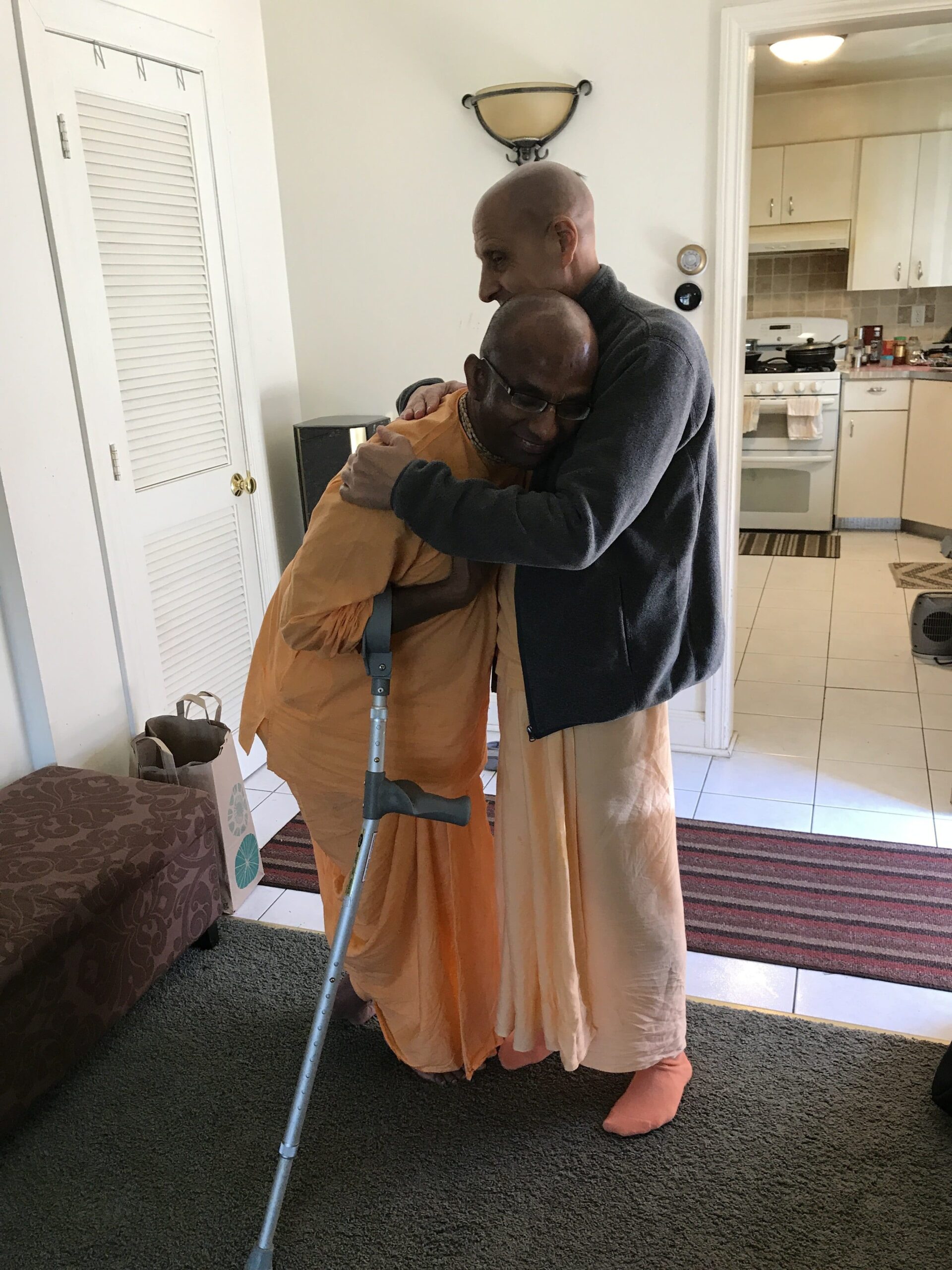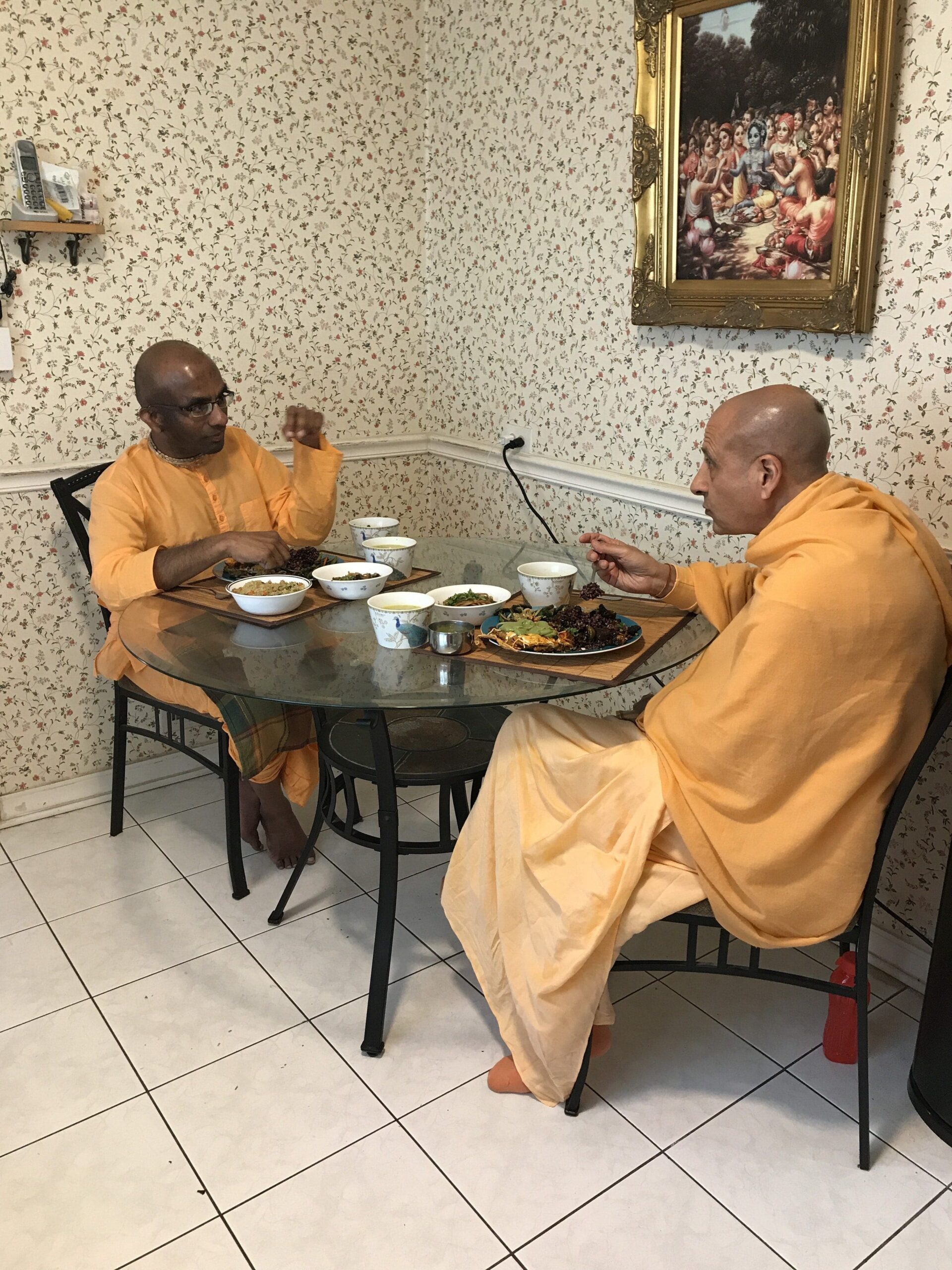2017 Spring tour of the West
My tour to the West in 2017 was the longest till date, lasting for three months and extending across forty cities in five countries: USA, Canada, Trinidad, Panama and UK. During the tour, by Krishna’s mercy, I gave around 132 classes and answered around 1000 questions. Here I share some of the highlights of the tour.
Programs for Western audiences:
Minding the Intel Mind
Perhaps the most significant program during my Western trip was a seminar at Intel, in Phoenix, Arizona, on the topic “MIND the MIND.” It was attended by around 25-30 Intel employees, who were engrossed in the subject throughout the whole talk.
I developed my talk using two acronyms MIND.
How we defeat ourselves:
Our mind
- Magnifies problems
- Imagines pleasures
- Neglects opportunities
- Denies reality
How can we stop defeating ourselves:
- Meditate
- Illuminate your inner world
- Navigate your inner pitfalls
- Do it with others
The feedback after the talk was that the content was simple and clear – the double acronym structure helped them understand readily where I was in the overall context of the talk.
During the QA session, a South American Intel employee asked whether we can ever come to a stage when the voice of wisdom within us becomes stronger than the voice of impulse. I answered that it is possible by studying wisdom-literature, adopting spiritual practices and especially by seeking the right social circle. After the program, she approached me and said that she came from a conservative family and had felt intense peer pressure to conform with the materialistic US culture. But on understanding the spiritual worldview and specifically the strategies for strengthening the conscience in the class, she felt inspired to stick to her higher values.
The program was organized by Sapna Kant (Sriji Priya Mataji), who works in Intel, and her husband Eshant Garg (Ishvara Gauranga P). They coordinate my online outreach. Being the first program of its kind at Intel, Phoenix, they had to expertly get it sanctioned through the Intel hierarchy. MNCs such as these are particularly cautious to not promoting anything sectarian.
The Intel India coordinator had been apprehensive about having a Hindu monk speak in their company. But he was relieved and pleased to see the positive feedback, especially by the non-Indians attending the program. And he said that the next time when I come to the US, they could organize a two- or three-part series.
Due to security and privacy considerations, Intel didn’t allow us to video record or even photograph the program, though they themselves clicked some photos and shared them with us.
I have spoken at several MNCs in the past, but Intel was the biggest MNC where I spoke. My small realization is that ultimately a similar heart beats in all people, whichever country they may be from and whichever company they may be working for. They all face the same eminently human issues that we all face – dealing with the mind’s stresses, and seeking greater satisfaction and better contribution. And for addressing those universal issues, the Bhagavad-gita’s timeless wisdom stands ready to empower everyone.
Caring for the minds of those who care for sick minds – Program at Carrier Clinic, Central New Jersey
Carrier Clinic is a behavioral healthcare center specializing in psychiatric and addiction treatments. In both the talks, I focused on the mind, analyzing its functioning from different perspectives.
The first talk was on “Spirituality changes how we perceive, process and pursue.” After the talk, one of the participants, a counselor for teens recovering from addiction, said that she had noted as many points as she could, but if there had been a book with this content, she would immediately have ordered it and recommended it to her clients.
The second talk about a month later was on “From will and power to willpower.” After the talk, a participant, a trauma therapist, said that the level of insight about the mind was so deep that he felt inspired him to study the wisdom-text (Bhagavad-gita) from which it had been drawn.
The talk was organized by Prem Chaitanya P, who is a consulting doctor at Carrier Clinic, and Devakinandan P, who is the vice-President of our Central New Jersey temple and who coordinated with the leaders of the various places I visited in America.
Talking on karma and appreciating the audience’s karma – Talk at Princeton University, Princeton
Vineet Chander (Venkat Bhatta P), who is the Director of Hindu Affairs at Princeton University and has become a close friend over the years, organized a talk on The Karma Conundrum – Does our destiny make us or do we make it? I have found that audiences all over the world are keenly interested in the topic of destiny because here philosophy intersects with reality in a way that matters tangibly to all of us. We all have experienced some higher forces working for or against us, and often they shape the results of our endeavors much more than our endeavors themselves.
The caliber of the Princeton audience (a result of their past good karma) was evident in their subtle and sensitive questions about karma and destiny, as well as their measured appreciation after the program. During a private conversation, a student, who is a department topper in his field, said that he found the talk insightful, though he didn’t agree with everything that was spoken. He felt that my saying that bhakti was the best way to spiritual elevation smacked of sectarianism – it undermined the esteemed path of jnana.
We didn’t have time to go into the technicalities about various paths, but I recognized that he had simply voiced what others in his position might have thought too. When speaking to an audience trained in critical thinking, it’s not easy to present the special position of bhakti without coming off as bhakti exclusivists. I am slowly learning this art by discussing with devotees who regularly make presentations to similar audiences and by studying how teachers of other paths present their philosophies without attracting the label of sectarianism.
Spirituality in the age of science – Balancing science, spirituality and audience interest
Most by college program organizers asked me to speak on “Spirituality in the age of science.” Not wanting to speak the same content again and again, I started approaching the topic from different angles in different talks. And I soon discovered that I had enough approaches to address this topic in a full book. One such talk centered on “The hard problem of consciousness” at the Texas A and M university, College Station. I explained how consciousness is the basis of all our knowledge – even the denial of consciousness requires the presence of consciousness. While research may show which areas of the brain are activated when we have different emotions and experiences, the emotions and experiences themselves can’t be reduced to anything mechanical, be it neural or digital.
At the universities where I spoke on the mind, the audience frequently asked many questions about emotions and relationships. Even among Indian college students in the US, dating is very common. While many youths in India demand the freedom to choose their partners themselves, talking with students in a campus where such choices were the norm revealed the flip side of that freedom: anxiety. Most of the students were in various phases of uncertainty, insecurity or animosity based on whether their relationships with their significant other was forming, fraying or breaking.
Living Spiritually in Today’s World – QA session at Bhakti Center, New York
Jai Giridhari P, a certified yoga teacher and the vice-president of the Bhakti Center, had invited me to speak at his Sunday afternoon called Recharge for yoga practitioners who want to go deeper into the yoga tradition. He had arranged the format of the program to be a QA session named – Ask. All the participants were Westerners and they asked many thoughtful questions. While addressing the overall theme of Living Spiritually in Today’s World, I highlighted the theme of positivity in spirituality, stressing how “What we are is God’s gift to us and what we become is our gift to God.”
Beyond emotion to intention – Talk at Ohio State University
My most attended program for a Western audience was at the Ohio State University. Naveen Krishna Prabhu, along with an inspired team, has been conducting a weekly vegetarian cooking class, which has over the years blossomed into a full-fledged program. Over one hundred and fifty students attended the program where I spoke on “Focus on conscious intention, not circumstantial emotion.” I explained how our intentions are often sabotaged by our emotions, and how we can subordinate our emotions to our intentions using spiritual wisdom and meditational practice.
After the class, a Chinese girl asked, “How can we conquer all our fears?” I answered that fear is an essential psychological defense mechanism that alerts us to danger, just as pain alerts us to physical danger. Fear is not the problem; fearfulness is. When fear continues to be present even when there is no danger, then fear morphs into fearfulness. The way to overcome it is by filling ourselves with positive, protective, purposeful thoughts – and the most efficacious of such thoughts are thoughts about our spiritual core and the whole to which we belong.
Beyond Conversion to Conversation – Christian-Vaishnava inter-faith meet at Washington DC:
The Christian-Vaishnava dialogue is the marquee achievement of the ISKCON Communications ministry and Anuttama P, who has been its insightful pioneer and my thought-provoking guide. He had invited, indeed insisted, that I be present for at least part of the conference.
As I participated in the conversations, I was intrigued to see the level of candor among the participants coming from two different faith-traditions. They had found common ground in their humanity and, putting aside their differences, had focused on the generic human issues that face religions in today’s post-modern world. Coming from India where Christianity draws a lot of flak from concerned Hindu circles because of its overt and covert conversion agendas, it was refreshing to meet Christians who had genuine interest in conversation, not conversion.
Thus, I realized a point that I have spoken often in my classes: we need to see people not by the designation of their religion, but by the level of their consciousness. Every religion has people in the three modes, and moderates, who are usually in the mode of goodness, can cut through the barriers of differing, even conflicting traditions, to establish authentic connections and conversations.
Challenging Christian conceptions – Bhakti in Mormon heartland Utah
America was started by Protestant Christians, but over the years it has become increasingly multi-cultural, especially in its public square. Though I had visited several places that were part of the Bible belt – states with high concentrations of evangelical Christians – none of those places had the overwhelmingly Christian demographic as did Salt Lake City. It is a part of Utah, which is the heartland of Mormonism, a rapidly growing branch of Christianity that was initially deemed as heretical but is now gaining mainstream acceptability and respectability, thanks partially to its including in its ranks a number of celebrities such as the self-help guru Stephen Covey.
When I saw the beautiful Krishna temple emerging out of the landscape – the scenic snow-capped mountains in the background – it brought to mind the phrase “miracle on a mountain.”
Caru Prabhu, a visionary Prabhupada disciple, has pioneered the bhakti outreach there. His magnum opus is the festival of colors (the Holi festival) that attracts thousands upon thousands of Westerners, and that program is now being replicated in various parts of America. By cultivating good relationships with the broader Mormon community and especially the Mormon church, he not only built a temple there, but also got a substantial donation from the Mormon church for building the temple.
The Sunday program there was attended by almost entirely Western people, mostly Americans and some other nationals – largely young people, students of the local Utah university.
I spoke on the topic of “Reincarnation – Evidence, Explanation & Implication” and expanded on how Christian theology is not incompatible with reincarnation. I drew attention to the well-known Biblical incident of Jesus healing a blind person. Prior to the healing, Jesus’ disciples asked whether that person had been born blind because of his own deeds. I pointed out that their question implied an acceptance of pre-existence before birth. “Otherwise, when could that person had done anything wrong to deserve being born blind? In the womb? What could he have done wrong there? Crossed his legs wrong?” The audience laughed good-naturedly and many looked deeply thoughtful.
I also quoted a Christian scholar, pioneering Sanskritist Sir Willam Jones, who acknowledged the inadequacies of the Christian explanation of the problem of evil: “I am no Hindu but I hold the doctrine of the Hindus concerning a future state to be incomparably more rational, more pious and more likely to deter men from vice than the horrid opinions inculcated by the Christians on punishment without end.” Again, the audience appreciated the logic of the point
Charu P and I had a stimulating discussion on the strategies used by Christian preachers in the US and India. He explained how well-organized the presentations of US Christian preachers are, how the lack of much deep philosophy in the Bible forces them to focus on the practical self-improvement aspects in their sermons, and how that focus resonates with people much more than philosophical technicalities. I explained how Christian preachers in India have been culturally flexible to penetrate the national mainstream India; they have been using Sanskrit equivalent of Abrahamic names for baptized people, composing Jesus Sahasra Nama, using local languages etc.
Caru Prabhu’s establishing a temple in the least likely of places, where almost everyone around belongs to a Church-centered, institutionalized religion that strongly ostracizes apostates, is a miracle indeed.
Have you had a near-death experience?
I often talk about how theoretical knowledge is different from experienced knowledge, but we don’t always know what we are talking about. I was reminded of this when I spoke at Jacksonville, Florida to students from the University of North Florida on “Near Death Experiences – Has the white crow been spotted?”
The title referred to renowned psychologist William James’ statement about the criterion to challenge ruling theories in science: ““If you wish to upset the law that all crows are black, you mustn’t seek to show that no crows are; it is enough to prove one single crow to be white.”
In my talk, I discussed a strong candidate for the white crow in near-death studies – a case that seriously problematizes the materialist dogma that consciousness originates in the brain. It is the case of Pam Reynolds who was made brain-dead as a part of a surgery called “operation standstill” and during that brain-dead period had a vivid near-death experience (NDE).
After the class, three among the twenty-thirty students said that they had had NDEs. Seeing this frequency drove home the reality of the statistic I had read: “IANDS (The International Association for Near Death Studies) reports that as many 14% people, especially in USA, have had NDEs.”
How commonplace near-death experiences were became even more apparent when one of them nonchalantly asked me whether I had ever had a near-death experience.
I answered that I had had not a near-death experience, but an out-of-body experience. Once nearly a decade ago I had been sick and had been hospitalized. While I was given an intravenous injection, something went wrong and instead of the fluid going into my body from the bottle, my blood started going into the bottle. I had dozed off during the injection. When I woke up and noticed what was happening, I became horrified and panicky. But suddenly I saw myself from an out-of-body perspective and immediately felt calm. After a few moments, I found myself back in my body. Still feeling calm, I pressed the nearby alarm button to call a nurse, who promptly fixed the problem.
My program in Jacksonville was held at the Bhakti House, a center run by a dedicated young couple: Amrita Keli Mataji, who is the Hindu Chaplain for the University of North Florida, and Lovelesh Prabhu, who is a software engineer.
One of the most inspiring features of being a traveling teacher of bhakti for me is seeing the commitment to outreach of devotees all over the world. Their dedication demonstrates that the zeal for outreach ignited by Srila Prabhupada burns strong in the hearts of his second generational American followers.
Learning from the audience
While I travel to speak on the Bhagavad-gita, I see myself primarily as a student of the Gita. And I have found that retaining such a learning mood helps me draw ideas and insights at even the unlikeliest of times. For me, learning from the audience doesn’t happen just during the class or after the class. In fact, most of this learning happens during my one-to-one meetings with people or even by overhearing casual words they speak while driving me for a program.
Understand, don’t judge:
During my Rama-Navmi class at a temple, a small girl sitting right in front of me was busy writing something in her notebook. I couldn’t but wonder, “Did she have some urgent homework? If so, why did she have to sit in the class and sit right in front?
After the class, she came with her mother and shyly gave me a painting – it turned out that she had been drawing me! As she liked to draw, she would draw the sights in the temple, including the speakers.
Seeing her devotional disposition, I was reminded of the danger of judging without understanding – something I had spoken repeatedly and what I had spoken just recently during a Rama-katha class when explaining how Vali had misunderstood Sugriva, leading to a lifelong rupture of a dearer-than-life friendship.
When she asked me, a little nervously “Do you like it?” I replied, “Yes, the painting is so good that I didn’t know that I looked so good.” As the devotees around us started laughing at the word-play in the appreciation, she hid her face in her mother’s legs.
Chanting as spiritual affirmation:
During my first program at Carrier clinic, when I was introducing chanting to my audience, I got a burst of creative inspiration and presented it as not just mantra meditation but as spiritual affirmation. After the class, the in-charge there who had coordinated the program told me that she found most appealing the idea of chanting as an affirmation. She explained that in the West, though meditation was becoming increasingly popular, it was not yet mainstream; it was still seen as Eastern or other-worldly. But affirmation was cool. Her words verbalized my inchoate sensation about the appeal of affirmations. I thanked her for her feedback and from that class onwards, I started introducing chanting as an affirmation for spiritual harmony, which meant, “O part, return to harmony with the whole.”
Can we love someone whom we hate?
During one of my meetings, a couple who I had known to be very close to each other told me that over the last few months their relationship had become very strained and that this was hurting both of them. Talking with them helped me realize that their anger was simply a distorted expression of their affection for each other. After churning on that thought for several days, I felt inspired to speak on “Can we love someone whom we hate?” at a congregation program in Portland. I spoke of five aspects of love – as attraction, as emotion, as intention, as expectation, and as action. I could see that the topic caught the attention of the audience and we had a stimulating question-answer session, both collectively and individually. When that couple heard the recording of that talk, they wrote to me saying that it helped them better understand what had gone wrong in their relationship and how they could set it right.
Contemplating fight or flight during a ride
When a devotee was driving me on a four-hour drive to his place, his daughter, a medical student whom he had picked up from a university along the way, started talking with her father. While I was busy chanting and contemplating ideas for my articles and talks, I couldn’t but over-hear their conversation. In one of the most open father-daughter interactions I had ever seen, she told him that they both had different approaches to life. Drawing on the psychological trope of fight-or-flight, she told him that he usually moved away from conflicts whereas she confronted them head-on – both, of course, with the intent of best dealing with the situation. Hearing their discussion gave me the idea to speak on the topic of “Go beyond fight or flight to sight.” There, I presented this psychological concept in terms of the three modes of material nature and explained how we can go beyond the mode of ignorance’s prompting for flight and the mode of passion’s prompting to fight by internalizing the sight that comes from scripture, thereby functioning in the mode of goodness.
Unusual experiences
Niagara falls & the flow of life – A meditation
While I was in Toronto, Anirudha P, one of my Canadian tour organizers, persuaded me to go to Niagara falls. Somehow , the idea of traveling to places just to see them doesn’t inspire me so much. But recently I have been meditating on the experiential genre of writing and speaking. So, I thought of going there not just to see the falls but also to speak and write on it. And just that thought put me in a much more spiritual frame of consciousness while traveling to and viewing the falls.
Seeing the falls triggered several thoughts such as:
- The beauty and power of natural phenomena point to the beauty and power of their trans-natural source. (Ref Gita 10.41)
- The flow of water produces spectacular sights sometimes, but the water keeps flowing towards ocean. So too can we aspire for our consciousness to keep flowing towards Krishna even when we are able to do something special. (Ref Bhagavatam 1.8.42)
- Physical divisions can be transcended by higher common purpose, just as the American and Canadian falls join together after falling. (Ref Gita 18.20)
I spoke these points in the below audio/video.
https://www.thespiritualscientist.com/2017/05/meditation-niagara-falls/
A Nigerian speaking Hindi at Denver Airport
At the Denver airport, a female wheelchair assistant greeted me in perfect Hindi, asking whether I was from Mumbai. I nodded and, as she was an African-American, I asked her how she knew Hindi. She had obviously expected that question and, with a pleased look, said that she had learned it by watching Bollywood movies. She had been hooked to Bollywood from her early teens, and years of watching Hindi movies had improved her Hindi. She was from Nigeria, but was now settled in the US as her husband lived there. Among all the passengers she assisted, she loved to assist Indians because she could speak Hindi with them. She said that Salman Khan had been her favorite hero for many years, but Dangal had now become her favorite move and she was considering whether she should make Amir Khan her new favorite.
Wheelchair assistants are trained to respect passengers’ privacy. If passengers don’t respond beyond basic courtesy greetings, they don’t usually talk much. So, when, despite my reticence, she kept talking – and talking animatedly – I was surprised. Till I realized that she was grabbing this opportunity to show off her Hindi.
Thinking that there was not much harm in letting her have that pleasure, I didn’t interrupt her. But while she was speaking, my mind went to a conversation I had about a decade ago with a Bollywood director at our Juhu temple. At that time, I had been working with HH Bhakti Rasamrita Maharaj to explore various options for presenting bhakti wisdom through videos for the mainstream audience. When the challenge of getting funds for making high-quality videos had come up, the director had said that many NRIs would be ready to sponsor such movies because they wanted to introduce Indian culture to their children born there – the only accessible introduction they presently had was Bollywood movies. I had been startled, thinking that Bollywood reflected very little of India’s spiritual culture and reflected sensuality and violence, which didn’t have anything specifically Indian to it.
Over the years, I had started paying more attention to trends in Bollywood, especially after I had been asked to comment on the movies OMG and PK, which had been satires of religion. Being much more interested in reading than in watching, I had started reading reviews of popular Bollywood movies to see where he industry was going. And it had registered in me that Bollywood is probably the single biggest shaper of the Indian mind. Now, while hearing this Nigerian speak typical Bollywood Hindi, it struck me that Bollywood may well be the single biggest shaper of the world’s perception of India too.
My mind went to how other religions are being affected by and are affecting the movie industry. Buddhism is the fastest growing religion in the West; and a prominent reason for its growth is that it has been frequently portrayed positively in Hollywood. Bishop Barron, an American monk based in Los Angeles, has become the world’s second most popular Catholic on social media (second after Pope Francis) primarily by giving Biblical commentaries on Hollywood movies. Many evangelical Christians have specialized artists, directors and producers making movies on par with professional Hollywood standards to convey Biblical themes.
We are sadly lacking in doing the same for our tradition. Of course, many devotees in different parts of the world are doing what they can for correcting this lacuna. The Hare Krsna TV channel started by ISKCON Desire Tree is one example. I felt grateful to be a small part of that outreach initiative. As I was thinking along these directions, we reached my plane. She dropped me off with “Alvida” and I thanked her with “Dhanyavad.”
This short interaction at Denver airport deepened my conviction that it is our responsibility to our tradition and to humanity at large to do our part in providing bhakti wisdom a much wider podium for outreach than what it presently has.
Skype Wednesday feast class for Boston
When I was to fly from Seattle to Boston, I got to the airport slightly late and the queue for checking in the luggage was so long that by the time we got through it, the time for boarding the flight had already passed. I had a Wednesday feast program that evening in Boston, but there was no flight to get me there in time. We re-adjusted the booking to a night flight, so that I could give class for the Boston audience via skype. To preclude any transmission problem, we decided that I could give the class in the temple which had a hi-tech facility for doing both YouTube live and Facebook live. When I gave the class, it was streamed through three channels – Skype, YouTube and Facebook. I found myself in a situation I hadn’t encountered before – speaking on a vyasasana to an almost entirely empty temple hall. I decided to keep the class short and we had a lively QA session not just with the devotees in the Boston temple hall but also several of the devotees from Seattle who too had joined online. (As it was afternoon in Seattle, most of them couldn’t come).
Radio show at Toronto
In Toronto, I did a radio show on “Karma and Reincarnation” where I spoke briefly and then answered questions that came live from the audience. Conducted by Ananda Gauranga P and his team, this was my first radio show and it was interesting to be on the inside of a program format that till now I had only seen as an outsider. I appreciated the innovative effort to spread bhakti wisdom through far-reaching channels and felt grateful to assist in some small way.
Trans-gender discomfort
After my hotel program in Panama on “Demystifying Reincarnation”, a couple of trans-gender devotees talked about the discrimination they faced because of their sexual orientation and asked how they could see it spiritually. I had addressed a similar question when I was in Detroit where after the Sunday feast a Vaishnavi Prabhupada disciple had asked, “How can we help people who feel that they have been born in bodies of the wrong gender?” Rather than getting into the morality of the volatile issue, I focused on the spirituality. No body is truly compatible with the soul; everyone feels discontented in some or the other way with the body they have. Rather than making a campaign for or against anything at the bodily level, it’s best to focus on raising our consciousness to the spiritual level and helping others do the same. If someone has fallen in an ocean, they may feel that their part of the ocean is stormier than another part, and may want to go to that calmer part. But in the process, if they neglect the rescue rope being extended from an overhead helicopter, that would be tragic. The process of bhakti-yoga is that rescue rope; which part of the ocean we are in and which part of the ocean we are going towards is not as important as our catching the rope. Rather than making a campaign for or against any kind of bodily change, it’s better to stress spiritual change – the raising of consciousness.
I concluded by telling those trans-gender devotees that they could focus on associating with devotees who understood them rather than judged them and in that association strive to grow in bhakti.
Speaking on dharma at Swaminarayan temple
During my second visit to Panama, I came to know that one of my talks had been scheduled at a Swaminarayan center where some of the organizers were receptive and some reserved. Anticipating their concern that their beliefs might be criticized, I used the strategy we use in any inter-faith meet: focus on the common purpose of raising consciousness. Accordingly, I spoke on Select emotions with intelligence focusing on how scriptural knowledge equips us to make the choices that raise our consciousness. Speaking in Hindi to an audience of almost entirely Gujarathi people, and that too in a country outside India, was unusual. And speaking at a forum that required the female audience to sit in another room felt surreal, almost like a throwback to another age.
Missing the point in Gaur Purnima talk?
This year I had the honor of celebrating Gaur Purnima at Phoenix, at nearly the opposite end of the globe from where I had celebrated it last year. In 2016, I had been on my Australia tour and had celebrated Gaur Purnima at Canberra.
Many temples in the US combine the Gaur Purnima celebration with the Holi celebration as they both happen on the same day. A little sprinkling of colors is added to the overall celebration that centers on Lord Chaitanya.
In Phoenix, I spoke on “Lord Chaitanya demonstrates that the heart is higher than the head” I find talks given on appearance days of the Lord challenging because the basic theme remains the same, at least in terms of the rationale for divine descent and the pastime of the descent of that particular avatara. I am not so spiritually advanced that the purity of my krishna-katha will keep the audience engaged. So, whenever I am asked to speak on festivals, I strive to come up with some fresh angle each year. This year on Gaur Purnima, I took the theme of how Lord Chaitanya defeated the topmost scholar of his times, defeating the best contemporary scholars at a prodigiously young age. Having thus attained the summit of scholarship, when he thereafter chose the path of devotion, he demonstrated by his life and choice that bhakti is not for the less intelligent, as is a common allegation. Bhakti is so inclusive as to be practicable even for the less intelligent and so profound as to be appealing even to the most intelligent.
After the class, a Prabhupada disciple told me that I hadn’t spoken anything about Lord Chaitanya being the combined manifestation of Radha-Krishna and his having come to give prema, which no other incarnation had given ever before. I replied that I had considered that point too advanced to be relevant for the largely new audience there. He disagreed, saying that we had a responsibility to make the audience advanced enough to understand it. After some contemplation, I saw the validity of his point – we had time throughout the year to speak basic points relevant to the audience; at least once a year on Lord Chaitanya’s appearance day, we could speak about his exalted mission and mood. I thanked him for his feedback and assured him that I would be more careful to speak in tune with the festival’s essence.
Actually, last year in Canberra, a Prabhupada disciple had given me the opposite feedback. He had told me that my Gaur Purnima Bhagavatam class Lord Chaitanya manifested the three internal reasons for his descent in his Ratha-yatra lila had been too advanced. That feedback might have made me subconsciously veer to the other extreme.
Science and Spirituality – From confrontation to reconciliation
The most cringe-inducing question I faced during my entire tour was in Washington DC where, after my Sunday feast class on Reincarnation, a Latino devotee asked, “As scientists keep people away from God, can scientists be considered reincarnations of demons?”
The question reflected a series of valid points linked together in a way that leads to a massive misunderstanding. I explained that we are not meant to judge people meant on what they may or may not have done in the past, but based on what they are now. And scientists are not intrinsically against God; they look for natural explanations for natural phenomena and so don’t bring God into their explanations as God is a supernatural reality. Newton believed in God, but for explaining the falling of the apple, he looked for a natural explanation and came up with the theory of gravity. Some scientists are against God, but their anti-theism comes from their own ideological orientation – it’s not intrinsic to science. And if we look at the kind of negative experiences with religion that some of these atheists had, we won’t demonize them – if we had similar experiences, we too would probably have become atheistic. So, rather than labelling scientists negatively, if we present the Gita’s message rationally, we will better do our part of making it accessible to everyone, including scientists.
This question-answer impressed upon me the urgency of addressing the much bigger issue of science-scripture difference in an intellectually responsible way. I have been pondering this issue for many years, especially with regard to the relationship between modern cosmology and Bhagavatam cosmology. Finally, after many years of study and prayer and discussion with many learned devotees, I have arrived at a five-point approach that I feel confident to present in any forum.
- Scripture doesn’t insist on one understanding of the universe eg Jyotisha cosmology differs from Bhagavatam’s cosmology
- Science too doesn’t insist on one understanding of the universe eg. Quantum physics and relativity offer models of reality that are irreconcilable, but both models work.
- Scripture’s purpose is to help us focus our mind on Krishna. By positioning scripture as a competitor to science, when the purposes of the two are different, we devalue scripture.
- Science’s purpose is to give natural explanations for natural phenomena. When it purports to make pronouncements about supernatural subjects, it often becomes scientism.
- Science offers the painkiller, scripture offers the curative medicine. We need to go beyond championing or demonizing the painkiller to taking the medicine.
While I have spoken on this overall theme at various places, I spoke on these points succinctly in a Bhagavatam class at the Bhakti Center: 5 reflections for reconciling science and scripture.
Sadhu-sanga
During my travels, I also got the association of many senior devotees who very kindly gave several hours of their time to discuss our philosophy and its practice. One recurrent theme was the challenge of presenting the personal philosophy of bhakti from within what seems like a highly institutionalized religion. Another theme was the strategies for making our message relevant to a highly individualistic audience with post-modern intellectual orientations. Among the devotees whose association I found inspiring were Brahma Tirtha P, a pioneer of mediation in ISKCON; Garuda P, scholar-author on Bhagavad-gita, Bhagavatam and the Bhakti-sutras; Bhakti Marga Maharaj, celebrated as the walking monk for his walking for spiritual awareness across the entire of Canada from one coast to the other; Guru Prasad Maharaj whom I met for the first time in Trinidad; Krishna Dharma P, the author of acclaimed retellings of the Mahabharata and the Ramayana; Srutidharma P, the temple president of the Bhaktivedanta Manor, one of the most successful temples in the Western world; and Tukaram P, a brilliant intellectual and Laguna Beach Temple President.
Along with these illuminating associations, the two that stand out the most for me are of HH Giriraja Maharaja and HH Radhanatha Maharaja.
Endearing reciprocity – HH Giriraja Maharaj
H H Giriraja Maharaj has been very kind to me in generously giving several hours of his time during each of my US visits. This year too, we spend nearly an entire day together at his place in Carpentaria, California. As I have served him as an editor, we naturally talked about his upcoming book on the history of the Juhu project which Srila Prabupada had asked him to write. He told me that his writing has gained substantial momentum and he is more than half way through. We discussed the challenges of balancing historical accuracy (reporting the facts as they are), dramatic intensity (writing to attract and retain the attention of readers) and interpersonal sensitivity (portraying properly devotees who had some difficulties then but now are in good standing).
When I asked Maharaj about the cultural conflicts going on in our movement and the concomitant bitter criticism of Vaishnavas, he said that he had discussed this issue with Tamal Krishna Maharaja, who had explained that such conflicts happen in every religion. And they happen because people are so emotionally invested in their beliefs and practices. They feel that if they get this thing right, their liberation is guaranteed; and if they get it wrong, their damnation is guaranteed. Because they feel that so much is at stake, they often deem as inviolable principles things that others see as adjustable details. Failing to appreciate others’ perspectives, they launch ad hominem attacks on those whom they perceive as threats to the tradition. I found this explanation the most intellectually illuminating and emotionally satisfying explanation I have heard till now.
Ishvara Gauranga P and Sriji Priya Mataji had driven me from Los Angeles to Carpenteria. After my meeting with Maharaj, Sriji Priya Mataji showed Maharaj her Gaur-Nitai Deities, Maharaj appreciated their beauty. Then with endearing reciprocity, he said to her, “As you have shown your Deities to me, I will show my Deities to you.” Although it was already 3 pm, way past Maharaj’s lunch time, he took us all to his Deity room which was filled with many Deities and then explained for more than half an hour the remarkable stories behind those Deities.
HH Radhanath Maharaj: Training through a Mock QA session
My meeting with my Guru Maharaj, HH Radhanath Maharaj, was by far the most memorable meeting for me. I met Maharaja for over three hours in Chicago at the house of Balaram P, which was the house where Maharaj stayed in his childhood and youth. There, Maharaj lives in the same basement where he spent much of his teenage and youth and deliberated life’s big questions – deliberations that prompted him to embark on the world-spanning and death-defying search for truth which he has described in his memoir “The Journey Home.” Though the basement has been substantially renovated and spiritualized, I could sense it as an arena where much deep contemplation had been done and was still being done.
Maharaj lives there without any of the trappings of guruship. In fact, he said that Chicago is the only place in the world where he has the privilege of driving his own car. And after our meeting, when Maharaj left to meet his father, I saw him get into a car, steer it around and drive it himself – a sight I had never seen before.
Balaram P told me of an incident that revealed poignantly Maharaj’s unassuming mood there. One night, Maharaj came out of the basement, coughing severely. He asked Balaram P whether they had a vaporizer. Since they had already used the one which they had, he told Maharaj that he would just go to a shop and get one. When Maharaj asked what was wrong with the one that was there, he said that they had already used it. Maharaj grabbed him by the shoulder and told him, “Just let me be a normal person. If you treat me as someone special, I will leave right now.” His declaration was revealing – it reflected an attitude opposite to the attitude of most people who would say, or at least feel even if they didn’t verbalize the feeling: “If you don’t treat me as someone special, I will leave.”
When I was told that I was going to have lunch with Maharaj, I was apprehensive, thinking that I would prefer to have my lunch later. But when I was told that that was the norm followed by all visitors including my senior godbrothers such as Govinda P and Gauranga P, I agreed, though not without nervousness.
Before the lunch, during my three-hour meeting with Maharaj, I gave a brief report of my programs at various places. He was pleased with my programs especially for Western audiences and even more so with my program at Bhakti Center. When we discussed about strategies for effective Western outreach, I mentioned that I had found the topic of the mind accessible and appealing to Westerners. Maharaj agreed and appreciated, saying that Buddhism had become big by focusing on mindfulness.
Explaining his strategy for Western outreach, he said that the Journey Home had positioned him as a bhakti seeker and thereafter Journey Within has positioned him as a bhakti teacher. Westerners are into yoga and are open to bhakti, but they have very little idea of bhakti philosophy – they conceive of bhakti primarily as singing spiritual songs. Journey Within was meant to make give them an accessible understanding of bhakti philosophy. When I asked about his future writing projects, he said that his publisher has suggested two books: The Spiritual Environmentalist, which can build intellectually on the practical work done at the Govardhan Eco-Village, and The Teachings of Lord Chaitanya, which can make the special love legacy of the Golden Avatara better-known in the Western world.
Zeroing in on the essence of any strategy for Western outreach, Maharaj told me that we need to learn to be more relevant and to shed the image of being sectarian. The Bhakti Center is his attempt to establish a forum customized for the needs of Westerners.
Knowing that I often address controversial questions, Maharaj spent nearly an hour in a mock QA session. He told me to ask him tough questions and he answered, and then I asked him questions about his answers, trying to understand why he had taken the answer in a particular direction and not another. I was astounded and delighted to see Maharaj in this role – as an expert answerer of questions, addressing tough issues logically, sensitively and faithfully. Seeing his dialectic dexterity was an inspiring revelation; it was like a foot-soldier discovering that his commander was super-expert in a weapon that the commander didn’t often wield.
Towards the conclusion of our meeting, Maharaj encouraged me to expand my outreach in the US, quoting Bhaktisiddhanta Sarawati Thakura: where there is greater need, greater mercy awaits.
London visit
During my London visit, I stayed for nearly ten days at the house of Sunderanand P who is a powerhouse of energy. He is one of UK’s leading surgeons in his area of specialization and had operated HH Radhanath Maharaj – that’s how he became introduced seriously to Krishna consciousness. He is one of the mentors and managers of the Bhaktivedanta Manor and he uses my writings and talks in his outreach. We bonded very well during my stay as he drove me to and fro for most of my evening programs.
His son Shyam Gopal P is one of the pioneers of the Pandava Sena and he efficiently coordinated my various programs in London. His daughter Neha Mataji, a Cambridge post-graduate in Economics, is the engine powering the RISE app that gives contemporary presentations of bhakti wisdom. For that app, I recorded a course on “Science, Spirituality and Life’s Big Questions,” focusing primarily on the question of identity with the related questions of emotions and free will.
At the College of Vedic Studies, Bhaktivedanta Manor, London, I gave two seminars:
Although I have spoken on Karna many times and within the devotee community I received much appreciation, many of those same answers when posted on public forums such as quora.com elicited much anger, animosity and even abuse. So, rather than continue with a presentation that alienated many, I decided to take a more sympathetic approach, acknowledging that Karna was grievously hurt, and then stressing that in instigating the public dishonouring of Draupadi, he had lost all sense of proportion and let his vengefulness become indefensibly excessive. I found the response to this angle so much more positive that if I ever write on Karna and the Mahabharata, I will be taking this angle.
- Destiny – Do we make it or does it make us?
This seminar attracted so many last moment registrations that the space in the seminar hall proved to be inadequate and devotees ended up sitting on the floor. I explained diagrammatically the various kinds of karma – prarabdha (manifest), aprarabdha (about to be manifested) sanchita (accumulated) and kriyaman (ongoing) as well as the various levels of causation – immediate, intermediate and ultimate. The point of how material knowledge and spiritual knowledge address these different levels of causation in different ways resonated with the audience. After the session, we had some of the deepest and the most practical questions of my whole tour, with questions ranging from the idea of a pre-ordained marital partner to the interplay of medicine and science with destiny .
Gita daily appreciation
For me, the most encouraging part of traveling and speaking is meeting people who are already connected with me through my sites. In Houston, I met a young man who is not connected with any temple but has been regularly reading Gita daily articles. He told me that the articles have helped him better cope with career uncertainties caused by Trump’s H1-B visa policy changes.
In New Jersey, I met a devotee mataji who told me that her husband, though born in a devotee family had been quite short-tempered, reducing her child and her to tears. But since reading Gita-daily for the last one and half years, he has become much calmer, and their family life is much smoother and happier.
In Salt Lake City, I met a Christian preacher who told me that he has been reading Gita-daily articles for over an year and has found himself agreeing with, even appreciating, 90% of what I say. When I asked how he had come to know about Gita-daily, he said that he had got a Gita from devotees doing street distribution and when he had googled to get more contemporary understandings of the Gita, he had found Gita-daily.
In Detroit, I met a Western devotee Mataji who said that she has been facing severe health issues that make it difficult for her to come to the temple and sometimes she doesn’t feel like even getting out of bed because of her sickness. But ever since she started reading Gita daily articles, she feels that each day she has something to look forward to, and that they have enlivened her enormously.
Knowing that I am able to assist people in coming closer to the Gita inspires me to keep studying and sharing its wisdom, even though I continue to struggle as a sadhaka in applying the Gita in my own life.
When I returned to Radha Gopinath mandir after three months and offered by obeisances to Srila Prabhupada, I felt deeply indebted to him. He had strived tirelessly to bring bhakti to millions the world over and I, despite my many limitations and flaws, am being used in some small way to share that glorious legacy. I felt my feelings encapsulated in a verse composed by Jiva Goswami in his introduction to Krama Sandarbha.
yad atra skhalitaṁ kiñcid vidvāṁsaḥ pūrayantu tat
yad atra sauṣṭhavaṁ kiñcid tad guror eva me na hi
Whatever errors are there in this commentary, may the learned souls correct it, and whatever good is found here belongs to my guru, not to me.

